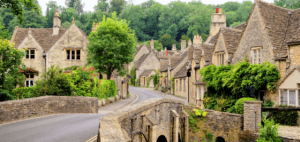Moai: The Easter Island Mystery Yet to Be Revealed
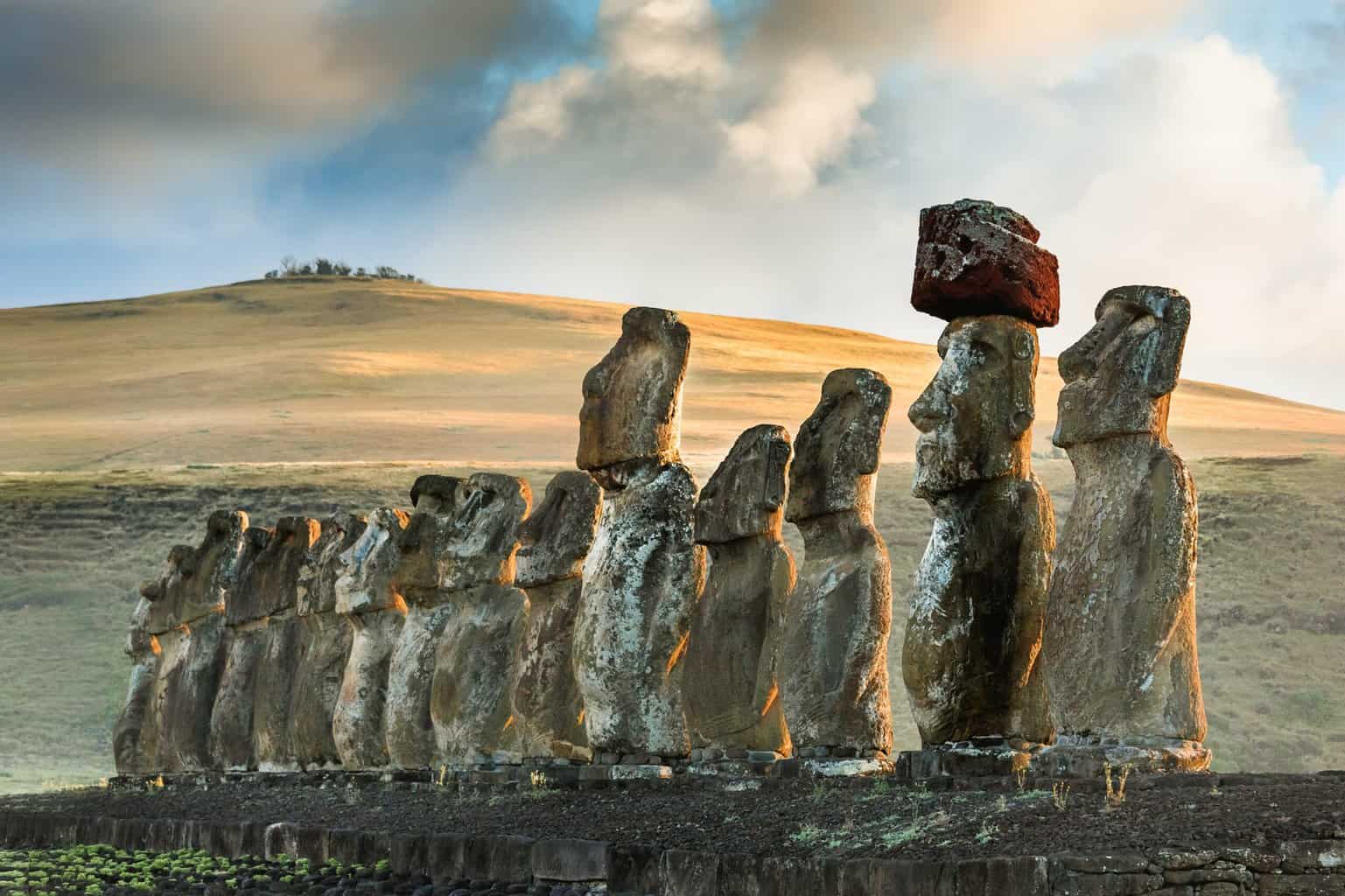
Updated On: November 08, 2023 by Noha Basiouny
Easter Island is a small remote island in the South Pacific Ocean, 3,686 kilometres off the coast of Chile. It has an area of 163 square kilometres and is home to 7750 people, as of 2017, living a simple, near primitive life.
It may seem like time had stopped on this island or that the rest of the world had forgotten about it. But Easter Island, in fact, encloses a very captivating mystery that makes thousands of tourists flock to it every year to see it. This has turned tourism into the primary source of income for the islanders and a crucial factor in how they are still able to survive there.
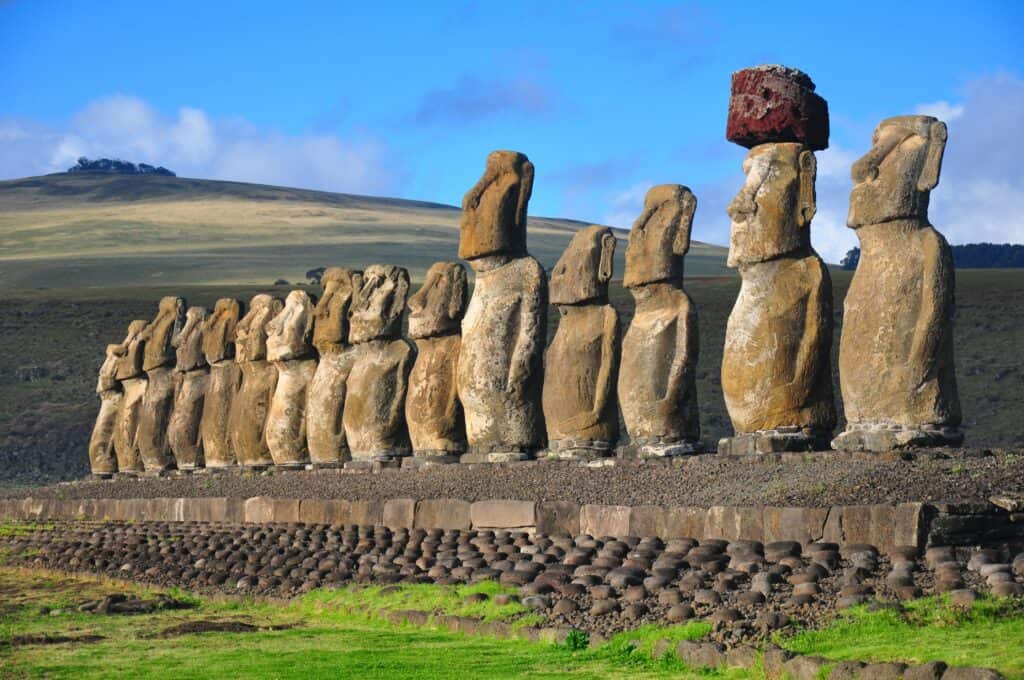
Besides the tiny population, Easter Island is home to over 900 gigantic statues known as the Moai and scattered all around the island. They resemble humans but not as accurately as the Pharaoh’s statues, for instance, but rather with so many differences. They have disproportionately large heads, elongated noses and ears, downward frown lips and inland-gazing eye sockets.
Ever since these statues were discovered, they have always confused explorers, archaeologists and everyone who had ever laid an eye on them. Everything around them is mysterious, from the purpose of their creation, the means by which they were moved to different locations, to the reason why they were all knocked down during the 19th century.
In this article, we are virtually crossing the Pacific and heading to Easter Island to learn the whole story of the Moai and explore what archaeologists have found that may reveal their mystery. So make yourself a large cup of iced coffee, and let’s hop into it.
Easter Island
The mysterious story of the Moai is strongly tied to their home, Easter Island, and the civilisation it had thousands of years ago.
Since 1888, Easter Island has been an official territory of Chile. It is part of the Polynesian Triangle, with New Zealand and Hawaii located at the triangle’s two other corners. It has an area of 3.1 million square kilometres and comprises over 1000 smaller islands. The people living on these islands are called Polynesians.
The ancestors of the Polynesians are believed to have lived in Southeast Asia before they migrated to these islands over 2000 years ago and settled there. They were known for their fantastic sailing skills and celestial navigation. They were masters at using the stars to guide them through the waters in the dark.
The history of Easter Island itself is roughly known. Some scientists claim that Polynesians arrived on the island in the year 800. In contrast, others believe they came much later than that, in the 13th century. Either way, the Polynesians created a great culture and distinct civilisation and called themselves Rapa Nui.
Besides agriculture, fishing, and sailing, the Rapa Nui built the super large Moai statues. According to scientists, those statues were built some time between 1250 and 1500 CE.
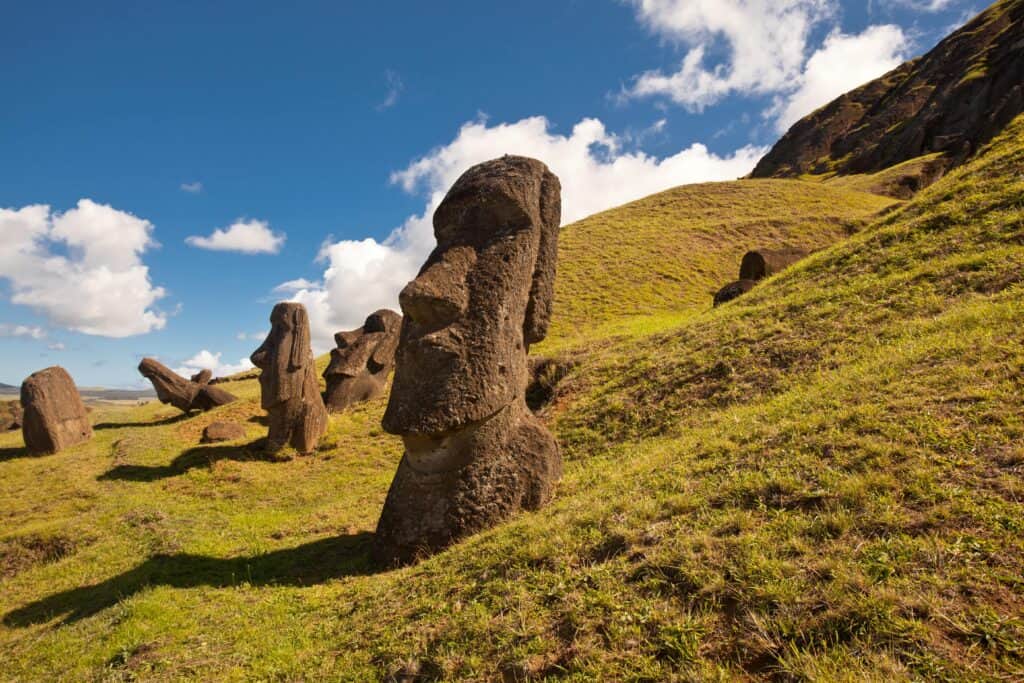
As we mentioned above, everything about the Moai is mysterious. Unlike the Pharaoh, who documented their civilisation on the walls of their temples, there is almost nothing that explains anything about the Moai. It is like the Rapa Nui were so good at carving such large sculptures but least interested in educating future generations about them.
Even the next generations did not care about documenting their ancestors’ greatest achievements. So when the Europeans arrived on the island in the early 18th century, which until then was a complete mystery to them, they were as astonished as they were puzzled.
So before we break down what is so mystifying about the Moai, let’s go quickly over the story of discovering Easter Island.
Discovery
Europe and Asia are connected by land and separated by water bodies from all other continents. So until some time in the 15th century, the world seemed to be made only of these two continents to whoever lived on them. But Europeans especially were pretty curious about the world and willing to go as far as their ships could bear to discover what was beyond the horizon. Many European explorers, most notably from England, Spain, Portugal, Italy and the Netherlands, set off to explore other lands.
India was discovered in the late 15th century. The Portuguese took the lead in exploring Africa, precisely its west coast, in the 16th century. Then in the early 17th century, the Dutch were the first to arrive in Australia, followed by British explorers around a century and a half later, who, by the way, claimed the entire east coast of the continent to the Queen as if it was no one’s!
Since ancient times, there has been a belief in the existence of a super large continent located way to the south of the planet. The Greeks called this mystery land terra australis incognita. Apart from the expeditions that crossed the oceans for trade, many others went on the search for this imaginary continent. In the early 18th century, the Dutch Captain Jacob Roggeveen was working in the West Indian Company and used to sail across the oceans on trade expeditions. Still, he himself believed in the existence of the southernmost continent and hoped he would one day set off to look for it.
Lucky for him, in August 1721, the West Indian Company provided him with two large ships and a crew of over 200 men, blessed his journey and prayed, like a beloved mother, he could fulfil his noble quest. The ships set off west, crossed the Atlantic, reached Cape Horn, the southernmost tip of the South American continent, and slipped into the Pacific Ocean, leaving behind the land and sailing straight toward the unknown. On 5 April 1722, which happened to be Easter Day, Roggeveen made a sighting of what was later called Easter Island.
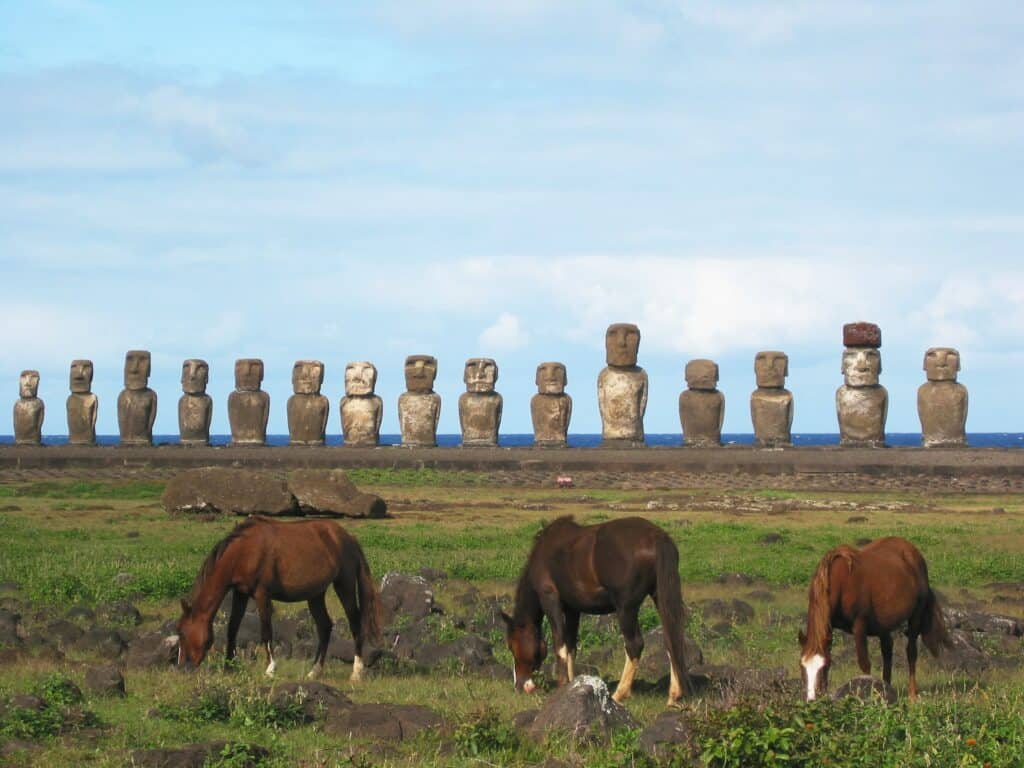
And just like how Columbus thought he reached India when he instead landed on an island in Central America, Roggeveen thought he finally found terra australis incognita. Reluctant to go ashore because of the lousy weather, Roggeveen waited a few days and then rowed with a bunch of his crew members to the island. The most notable of the many things that struck Roggeveen upon approaching the island was the giant statues resembling human bodies but with super large heads. The sculptures were scattered all around the already small island. They had different sizes and were so many, estimated in hundreds.
While more giant statues were further away from the shore, other smaller ones were found around the coast of the island, looking inward and giving their backs to the sea. Some statues had their heads only above the ground, and others showed their heads and shoulders, indicating that the rest of the body might be buried underground. Some statues also had hats.
Most of the statues were made from solid volcanic ash; each was curved of a single large dark grey rock in a minimalist style giving the most minor details to each body part. On the other hand, some were carved from either basalt or red scoria.
Additionally, all statues had well-carved eye sockets, but most of them did not have eyes. This, however, did not make the statues look scary but, on the contrary, pleasant to look at. All statues also had elongated noses, large ears and notably small frown lips. Roggeveen spent little time on the island. He soon left with his crew members and headed south, still searching for the mysterious southern continent. By the way, Roggenveen would later sail all the way to New Guinea without ever making sight of Australia.
Mystery
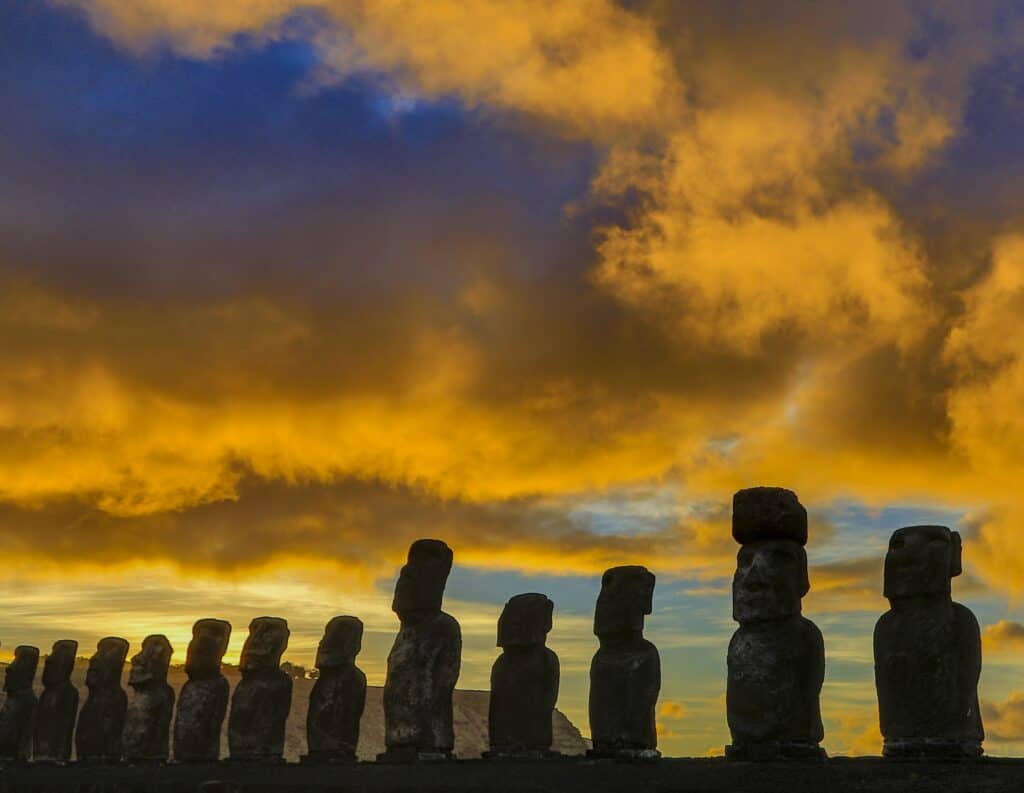
The Dutch and all the other explorers that would make it to Easter Island were shockingly astonished by the statues and everything that surrounded them, for everything around them provoked confusion and curiosity. Let’s explore some of what makes these statues that obscure.
Size
The first thing that confused so many about the Moai statues was their sizes.
As archaeology expeditions revealed later, the statues were estimated to be over 900 found all over the island. They were four metres tall on average, 1.6 metres wide and had a mean weight of 14 tonnes. Around 70 of these 900 statues were the largest, reaching a height of nine metres, with the tallest ever measuring 12 metres tall and weighing 82 tonnes.
The findings also revealed that the statues were carved from the volcanic tuff. After that, they were transported by what is still a perplexing method to different locations on the island and then erected.
The carving, transporting and erecting are all activities that required tremendous effort and advanced tools the Rapa Nui was not yet proven to have possessed. Moving the gigantic statues, in particular, is pretty difficult, for it needs complicated engineering and innumerable people while the population of the island is small.
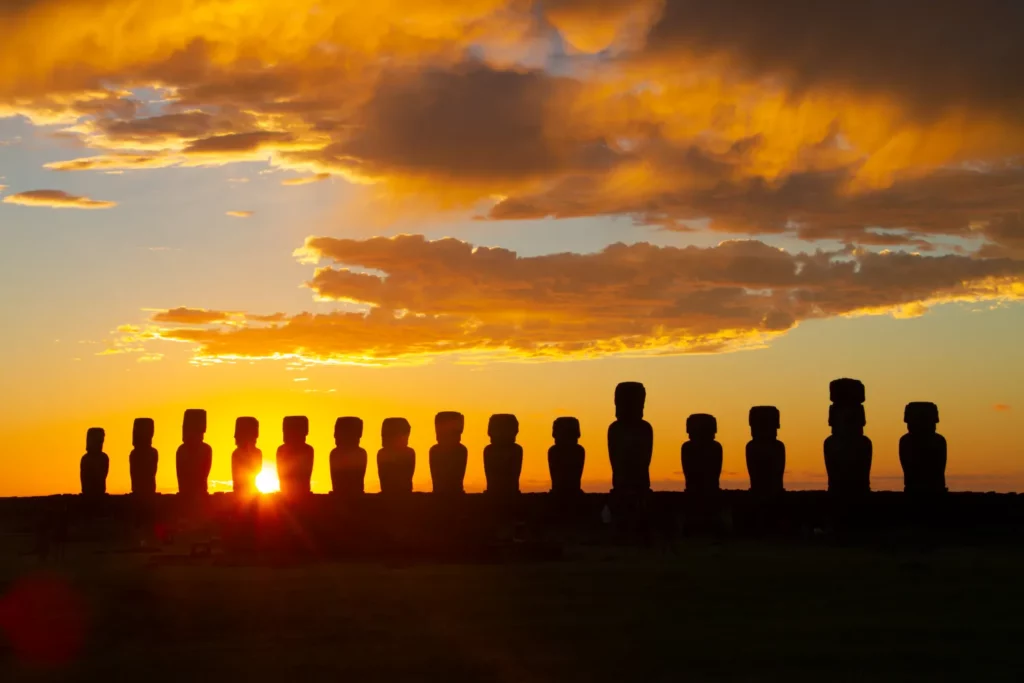
Purpose
Another thing that archaeologists and researchers could not justify is the reason behind building these gigantic statues.
As we mentioned earlier, it seems like writing was not a thing for the Rapa Nui. Archaeologists could not find any evidence of why the Moai were built and why the islanders bothered constructing them in such huge sizes. Understanding the purpose behind building them could be vital to finding the methodology, but so far, nothing for sure has been revealed.
Toppling
This takes the Moai to a brand new level of mystery and obscurity.
Around 50 years later, the Spanish arrived on the island and were just as amazed by the enormous standing statues as the Dutch. That was in 1770. Four years later, while on his way to find the southernmost continent, the British sailor James Cook came across Easter Island and again was surprised by the statues. Still, he later reported that some of them were toppled.
Another 50 years later, when Easter Island was visited by the French, the naval officer Abel Aubert du Petit-Thouars reported that only a few statues were standing when the rest of the 900 statues were toppled. In 1868 all the statues were reported to be knocked down.
Is that not super bizarre? How could it happen? Was it the result of a natural disaster? An earthquake, for instance? Were the Rapa Nui the ones who demolished the statues? If so, why would they ever do that? Why would they destroy their ancestors’ outstanding achievements?
This is another fact about the Moai that no one has a sure explanation for.
Theories
Until recently, everything we knew about Easter Island was pretty much the observations of the explorers who made it to the island and documented them in their journals. But no archaeological research was conducted on the island until 1955. By that time, Easter Island had already been annexed by the Chilean government for over 60 years.
Archaeologists spared no effort to untangle the obscurity surrounding these enormous Moai statues. The search for answers was hard. As we mentioned, there were no written records of the island’s civilisation. So what archaeologists came up with was more like theories that explain the mysterious points we mentioned above. However, nothing has been found so far to prove any of these theories true.
Anyways, let’s go over the theories one by one.
How they moved the statues
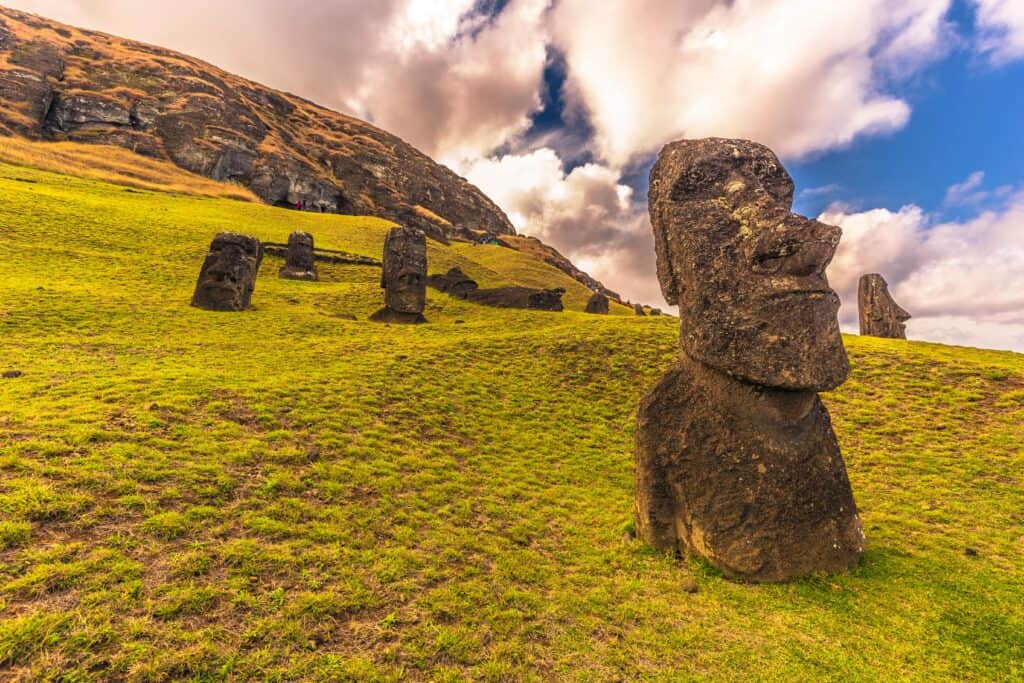
This could be one of the mysteries researchers spent a long time untangling. How could the Rapa Nui move their enormous statues all around the island? Well, multiple theories were proposed.
The first theory suggests that the Rapa Nui used ropes, tree logs, and sledges to move the Moai. The statues would be placed on the sledge, which itself would be set on logs that acted like wheels, and then the ropes were used to pull the sledge to the desired location.
While this could be theoretically possible, it is hard to apply in reality for many reasons. The first is that the statues are too heavy to lift from the ground to the sledge and then again for the sledge to the ground once it arrived at the location and then placed upright on the stone platforms.
Besides, when the Europeans arrived on the island, they reported that it was a grassland with no trees. This could mean that the island never had any trees, which would refute this theory. But even if the island did have trees in the past, it would require either a natural catastrophe or the Rapa Nui deforesting the entire island to become a grassland. Neither claim has not yet been proven.
Another theory of how the statues were moved is log rolling. By placing logs beside one another, laying the statues down on them then rolling the logs on the ground, they would be moved anywhere.
Likewise, this may sound more applicable than the sledging method, but when given much thought, it would be discredited. Besides the no-trees fact we mentioned earlier and the problem with lifting the statues, log rolling is even much more difficult as there was no way to prevent the statues from falling while the logs were rolling.
Why they built the statues
Why the Moai were built is another thing researchers have thought about for a long time. But like the other mysteries surrounding these statues, all they, the researchers, could do about that is just make some assumptions.
The first one suggests that the Rapa Nui built the Moai to honour their ancestors, which is why they have the shape of humans. The statues were gigantic to symbolise their power, wealth, status, and authority.
The fact that the statues are giving their backs to the and looking inward toward the village stands as a representation of how the Moai, the ancestors, cared for the islanders.
The Moai may have also been built to embody their powerful chiefs. Maybe because of that, the statues have different sizes. It is like there was a competition between the different clans to carve the largest statue as a way to resemble the most powerful chief.
Another assumption is that the statues were built to keep evil spirits off the island and protect the people. Because of that, the Moai were placed near the coast, standing upright like tall lighthouses to be easily seen by whoever was coming closer to the island and thinking about going ashore.
Why they destroyed the statues
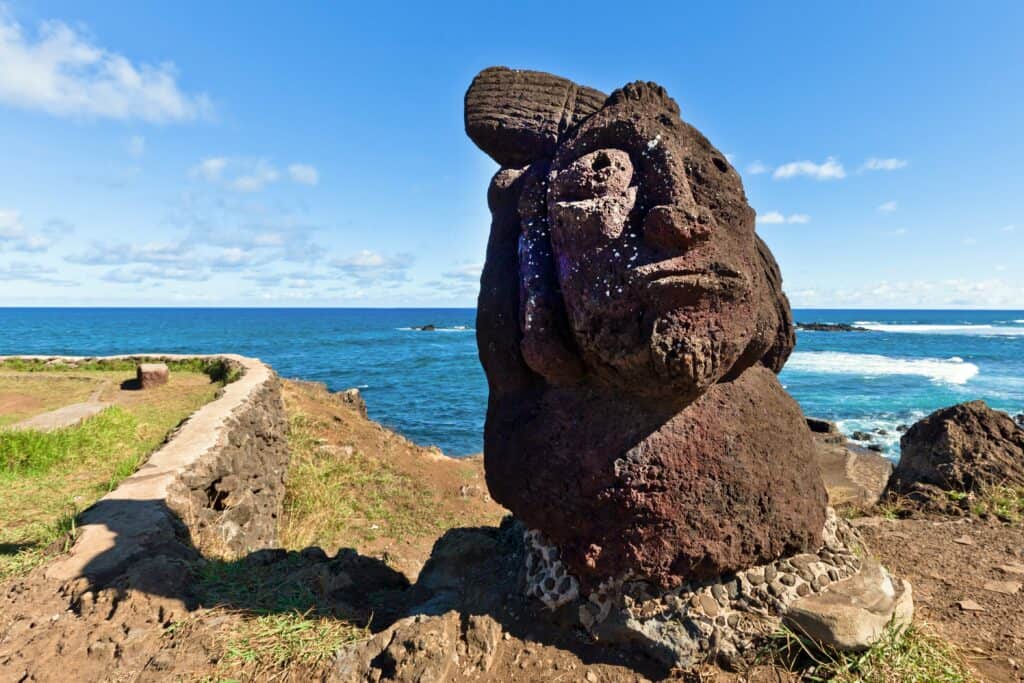
Toppling could have been caused by an earthquake, which is quite an acceptable and straightforward explanation for why super-heavy statues fell down. But given that they all were toppled over a long period of time, it would necessarily require a series of earthquakes to happen, but this could not be proven.
Another theory claims that the Moai were knocked down during wars between the different clans that lived on the island. A third one proposes that the Rapa Nui did destroy the statues themselves as they lost faith in their ability to protect themselves or the islands from disasters.
Once again, no evidence of any of these theories was found.
Just like we do not know whether or not the curse of the pharaohs is a real thing, what happened to Emilia Earhart when she disappeared, or if such a thing as Atlantis ever existed, the Moai is another alluring mystery that has evoked our curiosity for so long and no one really knows whether or not it will ever be revealed.
Yet, despite why the Moai were built, how they were moved to distant locations, or what knocked them down, they still stand as a great representation of the mastery, cleverness and technology the Rapa Nui once had.






